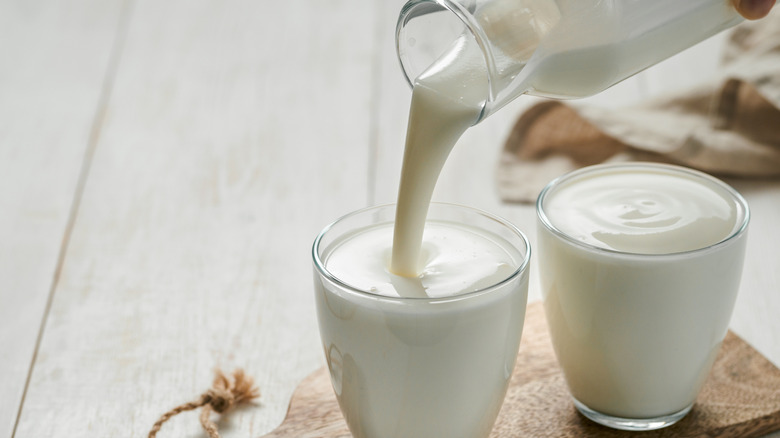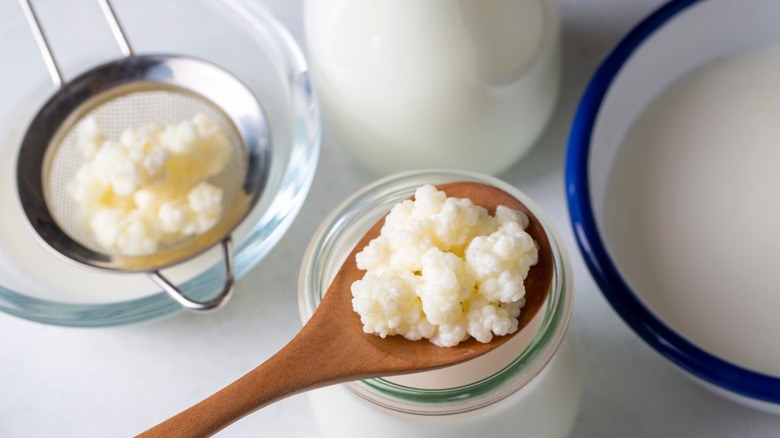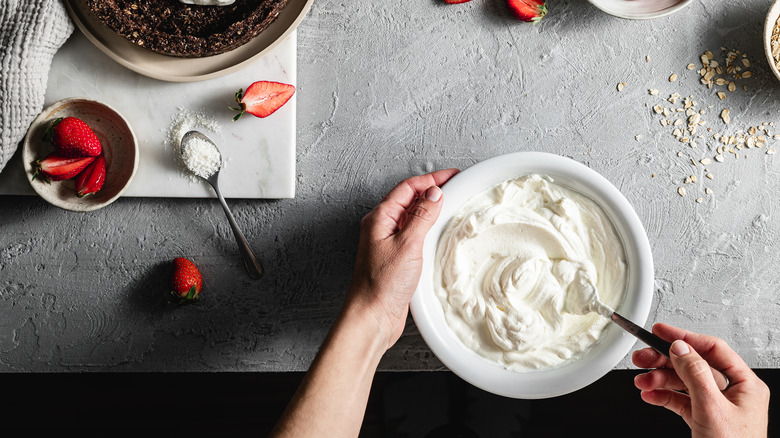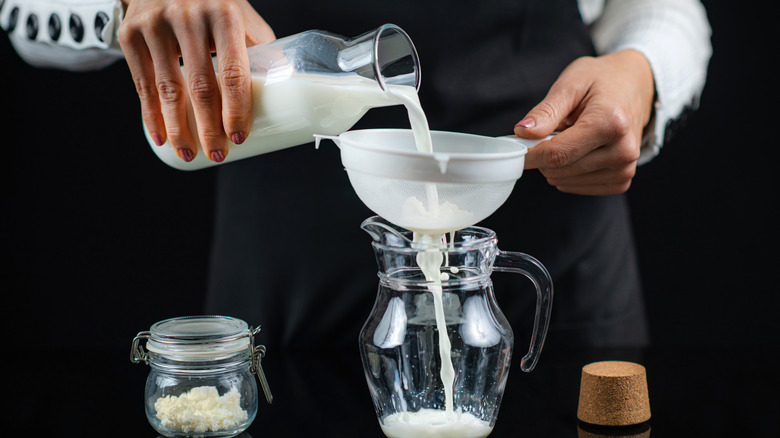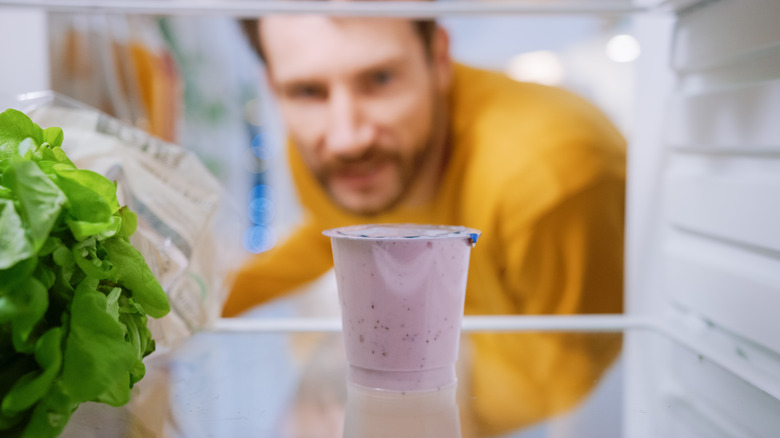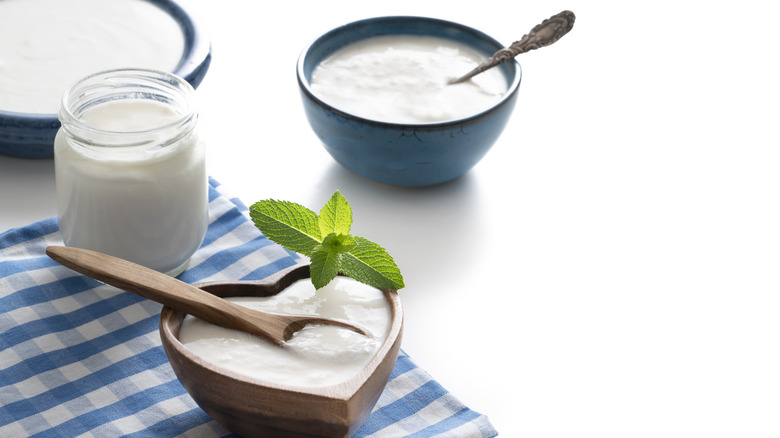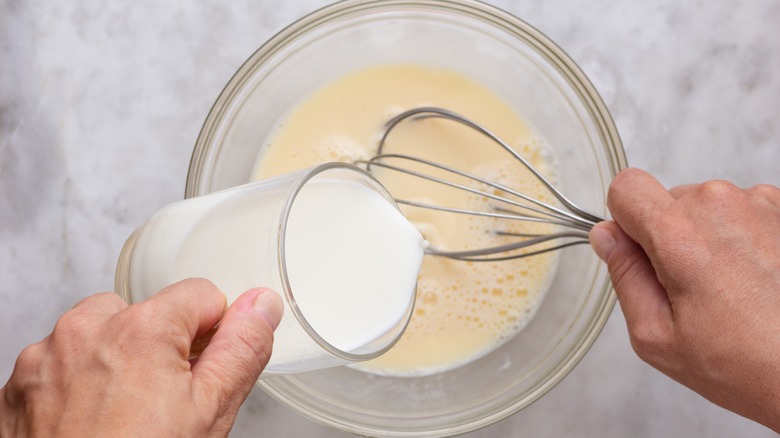What Is Kefir And How Is It Different From Yogurt?
You've heard of yogurt. You've heard of kefir. But, do you know what each of these dairy products is or how they're different from one another? Some people use the terms kefir and yogurt interchangeably. However, they are not the same thing. While there are several similarities between kefir and yogurt, there are also distinct differences in the way they are made, their taste and texture, their nutritional content, and more.
Understanding these key differences will help you understand the best ways to use kefir and yogurt, considerations you should make when cooking with either of them, and whether (or when) you could substitute one in place of the other for a specific recipe. We performed extensive research on kefir and yogurt, their similarities, and the key distinctions between each of the two dairy products. In the next few sections, we'll take a look at just what kefir and yogurt are. Then, we'll explore the different ways in which they are made and how those differences impact the taste, texture, nutrition, and cooking applications.
What is kefir?
If you've ever had kefir before, you might think that it almost seems like a cross between milk and yogurt. However, it is not so simple. Kefir is actually made using kefir grains — bacteria and yeast cultures — and fermented milk. The resulting substance is thinner than yogurt and thicker than milk. Because of its runnier texture, kefir is sold as a beverage that you can sip out of a cup or through a straw — it is not typically eaten with a spoon.
You may find two different varieties of kefir at your local grocery store: milk kefir and water kefir. Milk kefir, as described above, is made using fermented milk. Obviously, since it is made with milk, this variety is not considered dairy-free and wouldn't be a good choice for those with a dairy intolerance or those looking for vegan-friendly options. Water kefir, on the other hand, is not made using milk. It is made using either coconut water, fruit juice, or sugar water. It is a dairy-free and vegan-friendly option.
What is yogurt?
Yogurt is a spoonable dairy product that has been around for centuries. It is generally accepted that "yogurt" is derived from the Turkish word "yoğurmak" which means to coagulate or thicken, and it makes sense when you consider the thicker consistency of yogurt. The process of making yogurt can vary some, but it generally includes adding bacterial cultures to heated milk.
There are several different types of yogurt, which you've probably noticed if you've ever stepped foot inside a grocery store. Traditional yogurt is not strained, meaning it has a slightly thinner consistency than some of the other varieties out there. Greek yogurt, on the other hand, is thicker than traditional yogurt because the liquid and whey are strained during the production process. The taste of Greek yogurt is slightly tangier than traditional yogurt.
French yogurt has a creamier texture. It is made in each of the smaller containers that it is sold in, instead of in larger batches. Icelandic yogurt, also called Skyr, is another common variety. Thicker than even Greek yogurt, this variety is strained not once, not twice, but four times. Curds even form during its production, which makes it similar to cheese in many ways. Those with dairy or lactose intolerances can also find dairy-free varieties (made with coconut milk, almond milk, or other alternatives) and lactose-free alternatives (made using an enzyme that breaks down lactose).
Kefir vs. yogurt: production
The process for making kefir and yogurt is not the same. However, there are some notable similarities in the way they are made. While both products are fermented, the way in which the fermentation occurs is where the production of kefir and yogurt really differs. Both yeast (grain) and multiple species of bacteria are used when making kefir. The bacteria cause the proteins in the milk to curdle (known as lactic acid fermentation), while the yeast causes the substance to also go through alcoholic fermentation, where sugars are converted to alcohol and carbon dioxide. But, don't worry, the alcohol content in kefir is quite low (typically between 0.5 and 2%), compared to the 5% alcohol content for most regular beers. And, kefir is fermented for 14 to 18 hours after pasteurization, significantly longer than yogurt, which usually ferments for between two and four hours.
When making yogurt, no yeast is used. Only bacteria are added to the milk. Whereas several types of bacteria are used when making kefir, generally only two – Lactobacillus bulgaricus and Streptococcus thermophilus — are used to make yogurt. The addition of these bacteria causes the substance to go through the lactic acid fermentation process, but not the alcoholic fermentation process that kefir also goes through. This means that the proteins in the milk are curdled, resulting in the creamier texture you know so well. Yogurt is sometimes strained, while kefir is typically not stained, another notable difference in their production process.
Kefir vs. yogurt: taste and texture
Now that you've learned a little about how kefir and yogurt are made, it will be easier to understand the differences in the taste and texture of these two dairy items. Yogurt has a thicker consistency due to the coagulation of the proteins in the milk following the lactic acid fermentation. On the other hand, kefir is much thinner because of the carbon dioxide that is produced due to the addition of yeast during the fermentation process.
Beyond their different textures, yogurt, and kefir also have a different flavor profile. Generally speaking, the fermentation process gives both substances a tangy flavor. However, kefir is typically more sour and even tangier than yogurt and can even have a hint of yeastiness. The flavor of each of these fermented dairy products will also vary based on the addition of other ingredients, such as fruits. There are several fruits that are commonly added to both kefir and yogurt. Some popular ones include strawberries, blueberries, peaches and cherries. But, fruit-flavored kefirs are still prone to being a bit tangier than fruit-flavored yogurts.
Kefir vs. yogurt: nutrition
Kefir and yogurt are both generally considered healthy foods. The process of fermentation for both of these items leads to the production of probiotics, which can support a healthy gut. However, there are more probiotics in kefir than in yogurt — about three times as many. While most yogurts only have between two and six active, live probiotic cultures, kefir has about 12.
Because kefir isn't strained, it is also higher in protein. A cup of plain kefir made with whole milk has about 9 grams of protein, compared to less than 8 grams found in a cup of plain yogurt made with whole milk. That same cup of kefir will have about 300 milligrams of calcium, compared to just 275 milligrams of calcium in the cup of plain whole-milk yogurt. The sugar content of kefir is generally lower too, though this can depend on whether a manufacturer adds any sweeteners to their product.
One more nutritional benefit of choosing kefir over yogurt is the bioactive peptides it holds. When kefir goes through fermentation, the milk proteins are broken down. These broken-down proteins are called peptides. Studies are still underway exploring all of the benefits of bioactive peptides, but scientists are researching their abilities to support the immune system, cardiovascular system, brain, and more. Yogurt does have peptides too, but not as many because it is not fermented for as long as kefir.
Kefir vs. yogurt: storage
Kefir and yogurt should both be stored in the refrigerator. When perishable foods are left at room temperature for more than two hours, bacteria will begin to grow more quickly. This can cause the items to spoil and become unsafe to eat. Eating spoiled food can be dangerous; it may give you or others food poisoning. It is technically okay to store kefir on the counter, but only for very short periods of time. So unless you plan to consume it right away, you're better off refrigerating it.
To keep yogurt and kefir freshest and minimize bacterial growth, even in the refrigerator, store them in their sealed original packaging or another airtight container. If you end up with an excess of kefir or yogurt, both of these dairy items can also be frozen, though you may notice a slight difference in their texture when thawed. And, they can last up to two months when stored in the freezer, compared to just a few weeks when refrigerated.
Can you substitute kefir or yogurt for one another?
While kefir and yogurt are not identical, they are similar enough to substitute for one another in most recipes. However, keep in mind that each will lend a slightly different taste to the finished recipe. It is also essential to remember that the texture of kefir is thinner than that of yogurt. For this reason, you will need to make a few adjustments when using one in place of the other.
If your recipe calls for kefir, but you only have yogurt, you will need to thin out the yogurt before using it. Aim to follow a ratio of about ¾ cup yogurt with ¼ cup milk for each cup of kefir your recipe calls for. On the other hand, if your recipe calls for yogurt, but you only have kefir, you will need to thicken the kefir before using it. To do so, you can strain the kefir through a cheesecloth to remove some of the excess liquid.
Cooking with kefir
Drinking kefir from a cup or a container is far from the only way that kefir can be enjoyed. Integrating it into other recipes can help you benefit from the protein, probiotics, and other health benefits of the beverage.
Kefir's consistency is similar to that of buttermilk, so try using it to make pancakes, waffles, and any other recipes that call for buttermilk. With the probiotic cultures in the beverage, the kefir can really help deliver moist and delicious goods. You may also want to try making salad dressing using kefir. Again, its consistency lends itself perfectly to this task. You can add your favorite seasonings to enjoy a creamy, custom dressing. If you like spreading cheese on crackers, apple slices, or breads, stain your kefir through a cheesecloth. Doing so will leave you with a creamy substance that is perfectly spreadable and ready to enjoy. You could also always blend kefir with some fresh fruit and freeze the resulting mixture. In just a few hours, you'll have a frozen treat to enjoy.
Cooking with yogurt
Yogurt can also be used to make a variety of recipes in the kitchen. Like kefir, yogurt can make an excellent base when making salad dressings. Mix in the seasonings of your choice to enjoy a creamy and delicious addition to a favorite salad. You could even experiment with fruit-flavored yogurt for summer fruit salads. Because of how creamy it is, you can also add a few spoonfuls of yogurt into soups to give them a creamier taste and consistency, without all the added fat of using actual cream.
Another interesting idea for cooking with yogurt is to use it as a marinade. Yogurt has enzymes in it that can work to break down the proteins in chicken, steak, and other meats. When these proteins are broken down, the result will be a more tender finished product. If you're going to cook a dish with yogurt in a hot oven or on the stovetop, you might want to add some egg white or cornstarch into the recipe as well. These additions will act as a stabilizer to prevent the yogurt from curdling with exposure to these higher temperatures.
